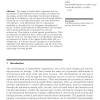Free Online Productivity Tools
i2Speak
i2Symbol
i2OCR
iTex2Img
iWeb2Print
iWeb2Shot
i2Type
iPdf2Split
iPdf2Merge
i2Bopomofo
i2Arabic
i2Style
i2Image
i2PDF
iLatex2Rtf
Sci2ools
ALIFE
1998
1998
Emergence of Multicellular Organisms with Dynamic Differentiation and Spatial Pattern
The origin of multicellular organisms and the mechanism of development in cell societies are studied by choosing a model with intracellular biochemical dynamics allowing for oscillations, cell–cell interaction through diffusive chemicals on a two-dimensional grid, and state-dependent cell adhesion. Cells differentiate due to a dynamical instability, as described by our “isologous diversi cation” theory. A xed spatial pattern of differentiated cells emerges, where spatial information is sustained by cell–cell interactions. This pattern is robust against perturbations. With an adequate cell adhesion force, active cells are released that form the seed of a new generation of multicellular organisms, accompanied by death of the original multicellular unit as a halting state. It is shown that the emergence of multicellular organisms with differentiation, regulation, and life cycle is not an accidental event, but a natural consequence in a system of replicating cells with growth.
ALIFE 1998 | Cell Adhesion | Cell–cell Interactions | Modeling And Simulation | Multicellular Organisms |
Related Content
| Added | 21 Dec 2010 |
| Updated | 21 Dec 2010 |
| Type | Journal |
| Year | 1998 |
| Where | ALIFE |
| Authors | Chikara Furusawa, Kunihiko Kaneko |
Comments (0)

